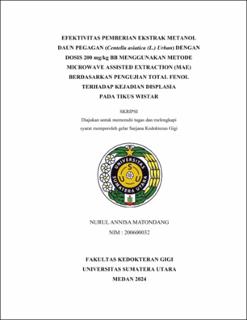| dc.description.abstract | Dysplasia or also called precancerous lesions are lesions that experience changes in the
epithelial tissue (stratified squamous epithelium) characterized by cellular atpia, loss
of maturation and stratification which has the potential to become malignant. The
compound 7,12-dimethylbenz (α) anthracene (DMBA) is one of the compounds in the
PAH group that meets the minimum criteria for carcinogenic potential. The pegagan
leaves (Centella asiatica (L.) Urban) is a natural ingredient that can be used as a
chemopreventive agent because it contains many bioactive compounds in the form of
alkaloids, flavonoids, glycosides, saponins, tannins, triterpenoids/steroids. As well as
polyphenols which have antioxidant properties which have the potential to prevent
cancer. This research aims to determine the effectivity of methanol extract of pegagan
leaves (Centella asiatica (L.) Urban) with a dose of 200 mg/kg BW using the
microwave assisted extraction (MAE) method based on total phenol testing for the
incidence of dysplasia in Wistar rats. This research is a laboratory experimental study
with a sample of 20 Wistar rats (Rattus norvegicus) and divided into 2 groups. In group
1, samples were given methanol extract of pegagan leaves kola leaves at a dose of 200
mg/Kg BW and induced by DMBA three times per week, group 2 samples were only
given DMBA three times per week. The degree of dysplasia in this study was measured
using a scoring system WHO 2017. The results of measuring the degree of dysplasia were then analyzed using descriptive tests and continued with the Chi-square test. The
results of this study show a p value of 0.301, so the p value is > 0.05, which means the
The effectivity of methanol extract of pegagan leaves (Centella asiatica (L.) Urban)
with a dose of 200 mg/kg BW using the microwave assisted extraction (MAE) method
based on total phenol testing on the incidence of dysplasia in Wistar rats was less
effective on the incidence of dysplasia because the difference with the control group
was not significant. | en_US |


